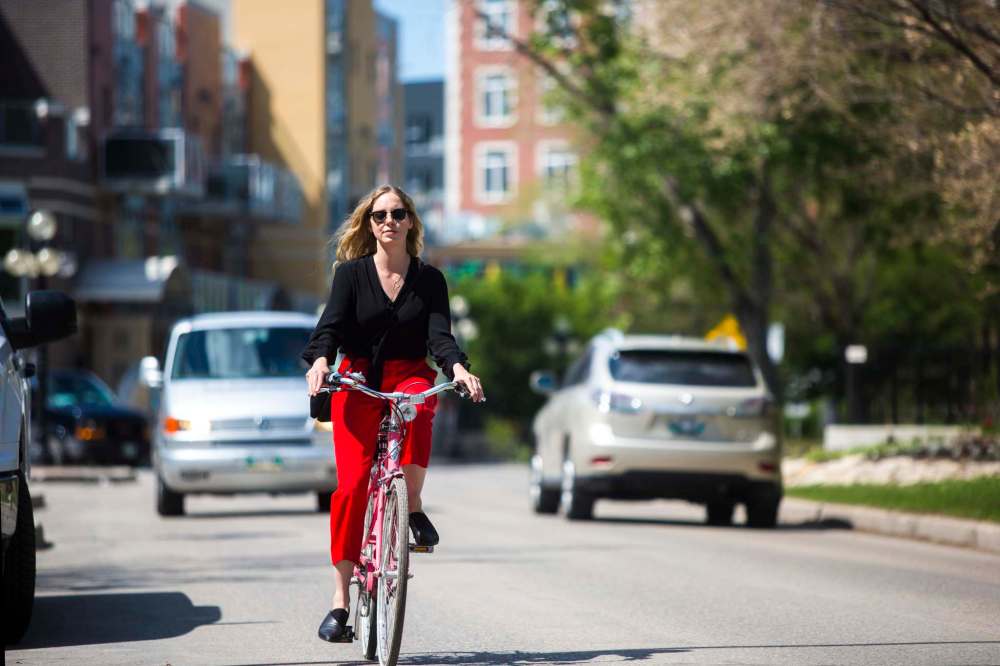MPI criticized for advising excessive cycling garb
Advertisement
Read this article for free:
or
Already have an account? Log in here »
To continue reading, please subscribe:
Monthly Digital Subscription
$19 $0 for the first 4 weeks*
- Enjoy unlimited reading on winnipegfreepress.com
- Read the E-Edition, our digital replica newspaper
- Access News Break, our award-winning app
- Play interactive puzzles
*No charge for 4 weeks then billed as $19 every four weeks (new subscribers and qualified returning subscribers only). Cancel anytime.
Read unlimited articles for free today:
or
Already have an account? Log in here »
Hey there, time traveller!
This article was published 17/06/2019 (1772 days ago), so information in it may no longer be current.
Some Winnipeg cycling enthusiasts took to social media this weekend to criticize a list of recommended safety equipment for cyclists published by Manitoba’s public insurer, saying it amounted to suggesting people wear battle gear to ride their bikes.
Erin Riediger said she first posted a picture from Manitoba Public Insurance’s cycling safety guide — which features a man wearing orange-tinted safety glasses, a yellow safety vest and reflective bands on his wrists and ankles — on Twitter Sunday because she thinks the guide makes cycling seem like a dangerous activity.
“When I first saw the photo, I thought it was a little bit comical because of the amount of gear that the cyclist was wearing,” said Riediger. “If anybody wanted to cycle in Winnipeg and they opened up this safety guide, it would turn them off immediately.”

This safety clothing guide by MPI makes cycling seem like a dangerous activity. To make cycling safer we need safer spaces to cycle & to encourage more ridership by showing people on bikes in normal clothes. Riding a bike is not an extreme sport and doesn’t require full PPE. pic.twitter.com/NdXv1YTr7g
— Erin Riediger (@erinriediger) June 17, 2019
She said the amount of equipment the province’s public insurer recommends cyclists wear is ridiculous, and puts the onus for road safety solely on people riding bikes.
“We don’t put the same sort of responsibility on drivers who could actually cause a lot more damage on the road,” she said. “Really, the issue isn’t what you’re wearing. It’s how the roads are designed and how you interact with traffic.”
Brian Smiley, a spokesperson for Manitoba Public Insurance, said the public insurer is in constant communication with Winnipeg’s cycling community for feedback to implement in its safety tips.
Smiley said MPI creates its handbooks keeping in mind bikes and cars are using the same roads — but one is protected by a lot more metal.
“A cyclist does not have a ton of steel protecting them (like) a motorist does,” he said. “Both groups are expected to share the road responsibly and safely, but in some situations that does not happen.”
Smiley said MPI recommends cyclists take extra steps — like wearing brightly coloured, reflective clothing — to keep themselves safer. The safety guide Riediger posted suggests cyclists wear safety glasses or sunglasses, gloves and reflective ankle and wrist straps. It also recommends using mirrors, a bell and a bike panier attached over the rear wheel to increase safety.
“For the cyclists, it’s a suggestion,” he said. “It’s nothing mandatory.”
Smiley said main issues that have come up in MPI’s consultations with the cycling community are people driving their vehicles too close to cyclists when passing them on the road, and forgetting that each bike has a person on it.
“We often lose sight of what a cyclist really is,” said Smiley. “It’s a person, it’s a mom, a dad, it’s an uncle, it’s a colleague.”
Riediger said cycling safety gear is important, but the focus on cyclists armoring up to hit the streets could create a false sense of security for people on their bikes.
“The most effective thing would be to be separated from the cars and eliminate the hazard of the cars,” she said. “The evidence is if you actually get hit by a car and you’re wearing a helmet, you’re likely to still be injured quite severely.”
Riediger said she hopes to see more local politicians push for investments in cycling infrastructure projects like protected bike lanes across the city.
caitlyn.gowriluk@freepress.mb.ca


